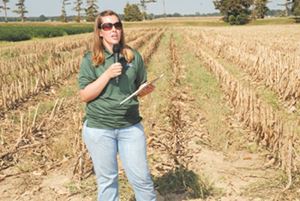|
Fall Fertilizer Application Can Buy Farmers Time
BATON ROUGE, LA.
LSU AgCenter research being conducted shows that farmers who grow multiple crops may benefit from applying some nutrients during fall if soil tests are completed first.
Growers have been interested in getting in their fields earlier, especially to plant corn, said LSU AgCenter agronomist Josh Lofton.
Corn production has changed a lot over the past few years, with growers using new varieties that allow them to plant much earlier.
“With the success of the past couple of growing seasons, many producers are seeking management decisions to either maintain or improve high yields,” Lofton said. “To achieve this goal, producers often need to improve management and efficiency of their fertilizer applications.”
In Northern and Midwestern areas, fall fertilizer applications are the norm because the colder winter temperatures don’t allow microbes to breakdown nitrogen like growers experience in the South, Lofton said.
“We don’t normally recommend nitrogen applications in the fall because of the warm temperatures and heavy rainfall that can cause nitrogen loss in our soils,” Lofton said.
LSU AgCenter soil scientist Beatrix Haggard, said they are not necessarily promoting fall fertilizer applications in all situations. But if the mix is right, it can pay dividends.

LSU AgCenter soil scientist Beatrix Haggard discusses the importance of getting soil tests done before applying fall fertilizer at the Macon Ridge field day in Sept. The tests show whether phosphorus and potassium will be bound in the soil or available for the crops.
Photo by Johnny Morgan
“In the fall, it is normally easier for growers to get into the fields to apply the fertilizer than in spring,” Haggard said. “So it helps in the management practice of getting more done in the fall than in spring.”
Haggard said growers in the North are able to put nitrogen out in the fall once the temperature drops below 50 degrees, but that is not the case in Louisiana.
As for potassium and phosphorus, soil texture plays a major role in the timing of applications, Haggard said.
“One of the issues that can occur with phosphorus is the binding that occurs in more acidic or basic soils,” Haggard said.
Different areas have different soil types, so the amount and duration of binding determines when crops will have these nutrients available, especially phosphorus, she said.
Fall fertilizer applications are usually least beneficial for corn and grain sorghum because they are planted so early while some of the nutrients are still bound up and unavailable for the crops, Haggard said.
“The message that we want to deliver to growers is that they need to look at their particular operation,” she said. “They need to be aware of their pH levels because that will determine the ability of the soil to release potassium and phosphorus.”
Nitrogen mobility is also an issue because of the normally heavy fall and winter rains in Louisiana, Haggard said.
Lofton and Haggard agree that soil testing and nitrogen management along with phosphorus and potassium management are critical practices for determining fall versus spring applications.
Many other production aspects have to be determined when deciding on fall or spring nutrient management, Haggard said.
Further assistance or guidelines in setting up a nutrient management plan are available from local LSU AgCenter offices.∆
|
|